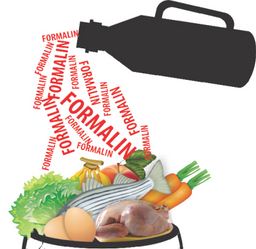Preservative
natural preservatives
natural preservatives
 |
| artificial preservatives |
Food preservation is the method used to make food has a long shelf life and retain properties physical and chemical of food.
In preserving the food should be noted the type of food preserved, the state of food, preservation, and appeal of food preservation products. Food preservation technology developed in today's industrial scale is based on the traditional ways developed to extend the consumption period of foodstuffs.
1. Natural Food Preservative
How does the fisherman keep the unsold fresh fish residue from decaying quickly and still selling in the market? Well, they use salt as a preservative to make salted fish. Although it feels different from fresh fish, salted fish still remain high protein.The following are examples of natural preservatives. a. Cane sugarSugar cane gives a sweet taste and is preservative. Fruits are stored in a concentrated sugar solution will be durable because the microorganisms are difficult to live in it
. b. Brown sugarBesides as a sweetener sugar is also preserving as sugar cane.
c. SaltSalt is a natural preservative generated by the evaporation of seawater. Salted fish can last for months because of the influence of salt.
d. TurmericTurmeric, other than as a dye, also serves as a preservative. With the use of turmeric, tofu or yellow rice to be not quickly stale.
e. Cinnamon barkskin Cinnamon is a bark that serves as a preservative because it contains lots of benzoic acid. In addition, cinnamon also serves as a sweetener and aroma.
f. CloveCengkih is a natural preservative produced from clove plant flowers. In addition to preservatives, cloves also serve as an aroma enhancer
. 2. Artificial Food Preservative ( Synthetic ) This artificial preservative there are various kinds, among others:
a. Acetic acid Acetic acid is known in the community as a vinegar acid. This material produces a sour taste and if the amount is too much will interfere with taste because this material is equal to some of the contents of our sweat water.Acetic acid is often used as a complement when eating pickles, chicken noodles, meatballs, or soup. Acetic acid has antimicrobial properties. Foods that use vinegar preservatives include pickles, tomato sauce, and chilli sauce.
b. BenzoateBenzoate is found in the form of benzoic acid and sodium benzoate (salt). Various types of soft drinks (soft drinks), fruit juice, nata de coco, soy sauce, sauce, jam, and agar are preserved using this type of material.
c. SulfiteThis material is commonly found in the form of a potassium salt or sodium bisulfite. Potato chunks, pineapple juice, and frozen shrimp are usually preserved using this ingredient.
d. Propil galatUsed in food products containing oils or fats and chewing gum as well as to slow the rancidity of the sausage. Propyl errors can also be used as antioxidants.
and. PropianatTypes of commonly used propyanate preservatives are propyanic acid and potassium salt or sodium propyanate. Propyanate in addition to inhibiting molds may also inhibit the growth of bacillus mesentericus which causes damage to foodstuffs. Preservatives of bread and cheese products usually use this ingredient.
f. Nitrite salt Nitrite salt is usually in the form of potassium or sodium nitrite. This ingredient is mainly used as a preservative of cheese, fish, meat, and also processed meats such as sausage, or corned beef, as well as dried foods such as pastries.The development of microbes can be inhibited by the presence of this nitrite. For example, the growth of clostridia in meat that can decay meat.
g. sorbateSorbat contained in the market is in the form of acid or salt sorbate. Sorbbat is often used in preserving margarine, juice, cheese, wine, and pickles. Sorbic acid is very effective in suppressing mold growth and does not affect the taste of food at the permissible level.
Prohibited Food Preservatives All of the preservatives described above are preservatives that are permitted to be used and licensed internationally by world health agencies (WHO) at permitted levels. However, either because they do not understand or deliberately, at this time still often found producers who use food preservatives that have been banned by the government.Preservatives that have been banned but are still frequently used include:
1) Borax or sodium tetraborate , with the chemical formula Na2B4O7.10 H2O is a compound commonly used as a raw material disinfectant, detergent, paint, plastic, or metal surface cleaner so easily soldered. Because borax is antiseptic and germ killer, this material is often used for cosmetic and wood preservatives.There are many cases of borax that are abused for the preservation of meatballs, sausages, gypsum crackers, wet noodles, molten bananas, lemper, siomay, lontong, ketupat, and dumplings. What is your attitude to this phenomenon?
2) Formalin is a trade name for a solution containing 40 percent formaldehyde (HCOH) in 60 percent water or a mixture of water and methanol (alcoholic type of spirits raw material) as its solvent. Formalin is often misused to preserve noodles, tofu wet, meatballs, and salted fish. The use of formalin in food can cause poisoning. Symptoms include dizziness, burning in the throat, decreased body temperature, itching in the chest, difficulty swallowing, acute abdominal pain accompanied by vomiting, and diarrhea bleeding. Formalin also causes damage to the central nervous system and circulatory disorders.The consumption of formaldehyde at very high doses can lead to convulsions, blood urine, and vomiting of blood that ends in death. Formalin is also carcinogenic (can trigger cancer) .
source:https://www.google.com/search?q=pengawet+alami+dan+buatan&hl=en-US&source=lnms&tbm=isch&sa=X&ved=0ahUKEwjqrpul2-zWAhVHoZQKHafTAEIQ_AUICygC&biw=1588&bih=773#imgrc=DqZ-EV42yePmYM:

0 komentar:
Posting Komentar